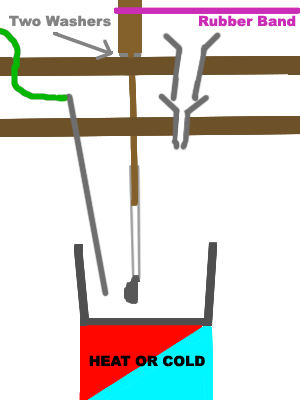METHYL GLYCOL DINITRATE
Methyl glycol dinitrate (propylene-1,2-glycol dinitrate or 1,2-propanediol dinitrate)
is an oily liquid, boiling at 92°C at 10 mm Hg. Its specific gravity is 1.368 (at 20°C). The liquid does not freeze at a temperature of —20°C. It
is more volatile than the isomeric propylene-l,3-glycol dinitrate.
...
In physical properties and explosive parameters methyl glycol dinitrate resembles
its isomer. The heat of detonation as 1110 kcal/kg (water as vapour). The expansion
produced in the lead block with water tamping is 540 cm3 [4J.
As early as in 1904 the substance was proposed [35] as an additive to lower
the freezing temperature of nitroglycerine, but its practical application on a large
scale was hindered by lack of the raw material, propan-1,2-diol. It is only recently
that the synthesis of glycol from ethylene led to the development of a method for
producing methyl glycol from propylene via chlorohydrin. Even so, propylene-
1,2-glycol is somewhat more expensive than glycols derived from ethylene.
1,2-Propylene glycol was nitrated by Naoum [4] using mixed acid composed of
40% HN03
60% H2SO4
at a temperature of 20°C to produce 187 parts of product from 100 parts of glycol,
i.e. an 86% yield.
A mixed acid containing
47.5% HNO3
45.5% H2S04
7% H2O
was used by Matignon, Moureau and Dode [36] at 10°C. By using 10% excess of
HNO3 they achieved a yield of 91-93%.
|



 , but the propylene
glycol commonly available is the 1,2 isomer.
, but the propylene
glycol commonly available is the 1,2 isomer.





 93Q8HK1rJgJ:www.dtic.mil/dtic/tr/fulltext/u2/766977.pdf+propylene+glycol+dinitrate+filetype:pdf&hl=pt-BR&gl=br&pid=bl&srcid=ADGEESiB
OJkRa4Jwa8_Udsf_cBsyXBbzRYb9WDF8D8uBeSaJLZAT4Mfgs8NLv9xjkpqTAVfL-0JogB5jgh5kVwrvZlMzC6-WO1paRZVjEKq4gDzZT2tukAIwrCN4As06kS936Vf_-98z&sig=AHIEtbRDp
Trvtl4Z04ScT-Qg4LA-UUBJOg
93Q8HK1rJgJ:www.dtic.mil/dtic/tr/fulltext/u2/766977.pdf+propylene+glycol+dinitrate+filetype:pdf&hl=pt-BR&gl=br&pid=bl&srcid=ADGEESiB
OJkRa4Jwa8_Udsf_cBsyXBbzRYb9WDF8D8uBeSaJLZAT4Mfgs8NLv9xjkpqTAVfL-0JogB5jgh5kVwrvZlMzC6-WO1paRZVjEKq4gDzZT2tukAIwrCN4As06kS936Vf_-98z&sig=AHIEtbRDp
Trvtl4Z04ScT-Qg4LA-UUBJOg 




